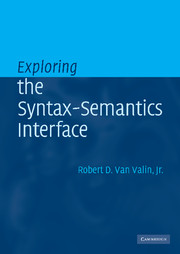Book contents
- Frontmatter
- Contents
- List of figures
- List of tables
- Preface
- List of abbreviations
- Introduction
- 1 Syntactic structure
- 2 Lexical representation and semantic roles
- 3 Information structure
- 4 Syntactic relations and case marking
- 5 Linking syntactic and semantic representations in simple sentences
- 6 The structure of complex sentences
- 7 Linking syntax and semantics in complex sentences
- References
- Languages index
- Subject index
5 - Linking syntactic and semantic representations in simple sentences
Published online by Cambridge University Press: 18 December 2009
- Frontmatter
- Contents
- List of figures
- List of tables
- Preface
- List of abbreviations
- Introduction
- 1 Syntactic structure
- 2 Lexical representation and semantic roles
- 3 Information structure
- 4 Syntactic relations and case marking
- 5 Linking syntactic and semantic representations in simple sentences
- 6 The structure of complex sentences
- 7 Linking syntax and semantics in complex sentences
- References
- Languages index
- Subject index
Summary
General considerations
The various components of a description of grammatical structure have been presented (clause structure, lexical representation and semantic roles, syntactic functions, focus structure), and now the principles that link them together will be presented. They illustrate the workings of the syntax–semantics–pragmatics interface. The linking algorithm is central to a theory like RRG that posits only one level of syntactic representation, for it must be able to deal not only with canonical clause patterns, i.e. those in which the default correlations between syntactic and semantic structure exist, but also with the non-canonical patterns as well. The general linking schema in RRG may be sketched as in Figure 5.1 on p. 129. The relation between logical structure and macroroles is mediated by the actor–undergoer hierarchy in Figure 4.4. The relation between macroroles (and non-macrorole arguments of the verb) and morphosyntactic functions is subject to extensive cross-linguistic variation and is affected by the privileged syntactic argument selection hierarchy in (4.14) and selection principles in (4.15) and by the extent to which focus structure is grammaticalized in clause-internal relational syntax (see Figure 4.3).
The opposition labelled ‘universal’ vs ‘language-specific’ in Figure 5.1 reflects the fact that there is very little cross-linguistic variation in the lexical phase of the linking and a great deal of cross-linguistic variation in the syntactic phase.
- Type
- Chapter
- Information
- Exploring the Syntax-Semantics Interface , pp. 128 - 182Publisher: Cambridge University PressPrint publication year: 2005



